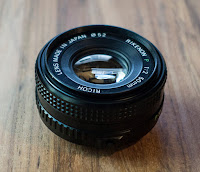I strongly suspect this lens to be one of the most sold tele-zooms, as I keep on finding them everywhere. I know have two in my collection, and have to be careful not to purchase another one.
The RMC Tokina lenses were positioned somewhere in-between the cheap consumer lenses and the more expensive professional grade lenses. The RMC designation was not always a sign of superior quality, but this lens is for sure one of the better older 80-200mm tele-zoom lenses you can find.
In a comparison in a Consumer Report in the 80's, the lens was selected as the top lens amongst 25 other similar lenses.
The lens is made from metal and has a good solid feel to it. Very smooth one-touch focus and zoom design without any focus or zoom creep when used in a downwards angle. Apperture ring works great, with full stops, but could be a tad smoother. That it also looks nice, is an additional bonus. Make no mistake though.. this is a large lens with some weight to it.
Image quality is great for an older zoom of this wide of a range. Nice colors, sharp across the zoom and aperture range and decent bokeh. Wouldn't mind taking this one out again with a tripod to really see how sharp it is. As I have two of these, I likely will.
The reach is just not enough for real birding, but it works great for the local pond. And a maximum constant aperture of 4 is pretty decent, especially with today's very sensitive digital camera's.
So again a great lens to add to your collection at an awesome price. And easy to find!
RMCRMC, or Rainbow Multi Coated, stands for a multiple of chemical coatings for lens surfaces with minimum light loss. The result is a dramatic improvement in both color fidelity and brightness and the elimination of flare and ghost images.
Lens Specification:
Focal Length: 80-200mm
Maximum Aperture: F4
Minimum Aperture: F22
Image Format: 35mm
Lens Mount: PK
Optics: 12 elements in 9 groups
Blades: 6
Focussing: Manual
Minimum Focus: 190cm
Maximum Magnification: unknown
Filter Size: 55mm
Weight: 575g
Length: 131mm
Production: unknown
Serial Number: 82211158
 |
| Original Brochure of Tokina 80-200mm Tele-Zoom lenses |
Samples:
All pictures taken with the Lens Turbo II adapter
 |
| 1/1000s - ISO2000 - Handheld |
 |
| 1/1000s - ISO3200 - Handheld |
 |
| 1/1000s - ISO1600 - Handheld |
 |
| 1/1000s - ISO2500 - Handheld |
 |
| 1/1000s - ISO2500 - Handheld |
 |
| 1/1000s - ISO5000 - Handheld |
 |
| 1/1000s - ISO5000 - Handheld |
 |
| 1/1000s - ISO1600 - Handheld |
 |
| 1/1000s - ISO2000 - Handheld |
 |
| 1/1000s - ISO6400 - Handheld |
 |
| 1/1000s - ISO2000 - Handheld |
 |
| 1/1000s - ISO6400 - Handheld |
Pentaxforums





































